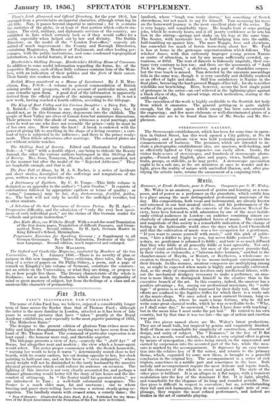/int ado.
PAED'S ILLUSTRATED TAM O'SHANTER.*
The name of John Faed has, we believe, enjoyed a considerably longer term of fame across the Border than that of Thomas Feed ' • although the latter is the more familiar in London, attached as it has been of late years to several pictures that have " taken " greatly at the Royal Academy exhibitions, and especially to the most popular painting of 1865, " The Mitherless Bairn."
The designs to the present edition of glorious Tam evince more so- lidity and higher draughtsmanship than anything we have seem from the hand of Mr. Thomas Faed. The command of particular expression is at least equal ; the humour more real, and therefore superior.
The titlepage presents a view of Ayr,—scarcely the " Auld Ayr " of Burns, but altogether neat and modem ; the view which a house-agent would select. The series proper commences with the Scotch housewife, " nursing her wrath to keep it warm "-' determinedly seated close to her hearth, with its scanty embers, her cat dozing opposite to her her clock pointing to half-past ona and on her brow a smva indignatio," whose moral weight will not be diminished to the tardy husband by the massive physical proportions which could enforce its sentence on occasion. The lighting of this interior is not very clearly accounted for, and perhaps a dimmer glimmering would better tell the story of late hours and the dis- comfort of sitting-4. In " the Souter tauld his queerest stories," we are introduced to Tam ; a well-built substantial scapegrace. The Souter is a much older man, fat and unctuous ; one to whom boozing and queer story-telling have become a serious steady-going oc- cupation. The landlady stands with crossed arms, a comely dame; the
• Tam O'Shanter. Illustrated by John Taal, R.S.A. Published for the Mem- bers of the Royal Association for the Promotion of the Fine Arts in Scotland.
landlord, whose "laugh was ready chorus," has something of Scotch shrewdness, but not much to say for himself. Tam mounting his mare on the homeward journey is the most excellent plate of the series. Ho is very happy, and remarkably tipsy. Ho laughs loud at some parting joke, which ho scarcely hears, and is all jaunty confidence as he sets his foot in the stirrup—springy and shaky on his legs at the same time. The Souter, with inveterate leer, is half-helping hint into the saddle, half-tumbling up against him. The mare Maggie, here and elsewhere, has somewhat too much of heroic horse-form about her. Mr. Faed is less at home in the grotesque supernaturalism which follows. The witches' dance, with that extremely improper young person Nannie as centre of attraction, is not by any means sufficiently crowded, up- roarious, or fitful. The rout of dancers is hideously ungainly, their cos- tume very contrary to bon ton; and there are the accessories of "Auld Nick in shape o' beast," a skeleton, and a pair of chandelier corpses : but the true touch is missed. Tam detected by the uncannie assemblage fails in the same way, though it is very carefully and skilfully rendered as an effect of light and shade. Still less satisfactory is Nannie in the final plate, bereaving the hard-pressed Maggie of her tail ; for she is neither witchlike nor bewitching. Here, however, occurs the beat single point of grotesque in the series—an owl relieved in the lightning-glare against a black abyss of sky, his spread wings struck motionless, staring at the unblessed sight.
The execution of the work is highly creditable to the Scottish Art body from which it emanates. The general getting-up is quite sightly enough, but the point upon which energy has been concentrated is the engraving; and few more elaborate or well-discriminated plates of a moderate size are to be found than these of Mr. Stocks and Mr. Ste- phenson.






























 Previous page
Previous page